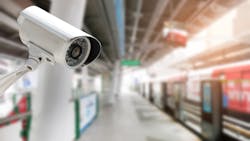Most transit agencies still rely on siloed, proprietary systems for daily operations. However, due to rapid digital transformation, increasing urbanization and growing expectations from commuters and governments, transit organizations are beginning to modernize and explore ways to enable closer collaboration.
Today’s commuters and municipal partners are increasingly expecting data from transit systems to be made available to support their decisions regarding which methods of transportation to take and when. Legacy systems make this challenging since they don’t always communicate with one another or provide an easy method to share data.
Getting one legacy system to talk to another often requires costly customization, and the result tends to be cumbersome and costly to maintain. Transit security systems are also becoming more complex, connecting an ever-growing number of sensors, cameras and Internet of Things (IoT) devices.
Upgrading to a modern, unified security system provides a solution. A unified system brings data from all devices and systems into one software platform, so you can see everything in one place. It can help improve collaboration, enable data collection and sharing among stakeholders, optimize daily tasks, reduce cybersecurity risks and more.
With so many opportunities, it can feel overwhelming to try to filter out the noise and figure out where to start. To keep things simple, don’t begin with the technology. Begin with your mindset.
Overcoming departmental silos
Departmental silos have existed for so long that we often don’t question the divisions. One group may manage buses and another manages subways or light-rail transit. Operations staff members don’t talk to the maintenance team, and teams may be divided into separate groups for maintenance and infrastructure. As a result, your transit organization may be paying for duplicate security, operation systems and other redundant technology that duplicates effort and adds unnecessary bloat to your budget. Onboard systems that do not communicate with wayside infrastructure systems are often a source of redundant technology.
Making the switch to a unified system isn’t just something that benefits just one team. The power of a unified system is its ability to bring data together from disparate systems and departments and present it intuitively.
A good starting point is to get everyone in the same room to talk about challenges and explore how to structure a solution that can benefit everyone. Once you have a clear understanding of your obstacles and goals, you’ll have a much better idea of what technologies can support you.
Consider inviting other like-minded municipal agencies to be a part of the conversation. Transit agencies aren’t unique in what they’re searching for. Other departments in your town may be wrestling with similar challenges. Communicating with them early on can help you learn from each other’s experiences, so you can find better solutions.
For example, law enforcement agencies often have to find solutions for doing more with less and can use data gathered through the transit infrastructure. Many departments have been successful in leveraging technology to do this.
What can you learn from their successes? What mistakes did they make that you could avoid?
Consider whether there are any agencies or departments with whom you could join forces to share systems or data. Urban planning departments, for example, could benefit greatly from having more in-depth knowledge of how people move within a city or perhaps your region’s department of transportation would consider partnering to reduce congestion. The more data you can share, the better view you have of how people move from here to there.
Consultants can be useful to facilitate the conversation. Talking to vendor representatives can also be helpful. Take the time to identify partners who think like you or who have the same goals you have. You want everyone at the table to be motivated to progress in the same direction.
Improving passenger experience
When onboard systems are connected to wayside systems, transit agencies can more easily optimize how to deploy fleets and reduce bottlenecks at bus stations, bus stops and parking lots. Transit authorities are just beginning to explore how powerful data from video analytics, light detection and ranging and other systems can be. Some are even experimenting with predictive analytics, so they can reroute buses to respond to anticipated spikes in demand. This type of use case is still in the early stages but will become more advanced soon.
This data can also be used to improve the passenger experience. For commuters, knowing whether a bus or train is late, or which train car is least crowded, can make a huge difference in their day. They want to be able to quickly check when the next bus is arriving, pre-pay their fare or parking fees online or reserve a parking spot for tomorrow. All of these outcomes require an approach to technology built on non-proprietary open platforms that allow easy data sharing and aggregation for analysis.
A unified system can also improve passengers’ and drivers’ sense of personal safety. Staff and passengers feel more secure knowing security will respond quickly and effectively if there’s an incident on board a bus or near a station. When passengers report issues, having a record of what happened on board helps your team respond to the complaint. Video recordings, along with telematics data, can help to sort through the scenario to determine what happened.
Making the switch
The first step to transition to a unified system is to identify any closed systems you may have and replace them with solutions that run on open-architecture platforms. It’s difficult to build a single source of truth in a unified system if you have some data sources that don’t communicate with other systems. The ideal scenario is to have everything operating on the same software. However, you can start by bringing data from open systems into a unified platform.
It's okay to take it slow. Start by identifying the biggest pain points, then fix them one at a time. Trying to do too much becomes a massive undertaking that can seem daunting. Like any journey, take it one step at a time.
For example, if you have three similar systems running, could you move towards harmonizing them into one shared system? Some common hardware like cameras, access control sensors or door controls may work perfectly well within your new unified system.
Look for the quick wins, too. You may be able to leverage some technology you already have. Perhaps you already have sensors in your subway tunnels to detect the presence of people or animals. Data from those sensors could be useful for security, operations, maintenance teams and even law enforcement.
Technology can also enable policy solutions. For example, if you have automatic license plate recognition cameras in parking lots, you could add analytics to get a better picture of how many people use those lots and create new incentives based on that. You could even designate a row of parking spots close to the station for carpooling and use video analytics to enforce this.
Technology is always advancing. Internet-connected sensors are being added to monitor air quality, keep track of battery levels on electric vehicles and even monitor driving behavior to ensure safety. More data and new possibilities will be available in the future. An open-architecture security system allows you to add new features as they become available.
-------------------
Jermaine Santoya is the industry marketing manager for Genetec Inc.

